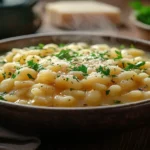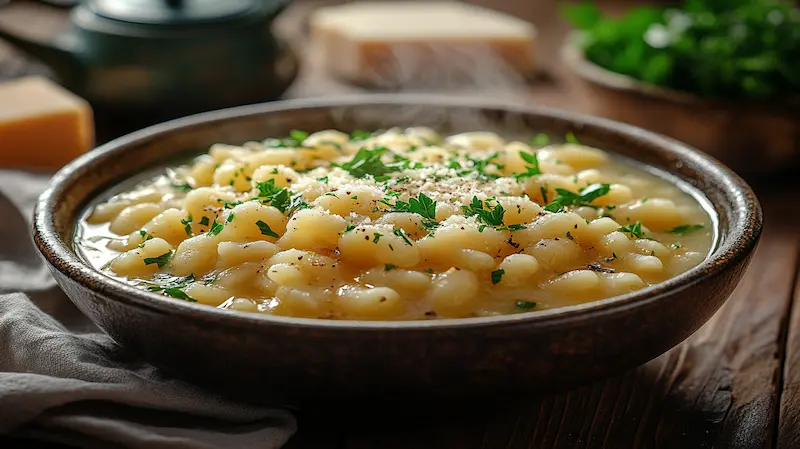Table of contents
Pastina eggs, the smallest type of pasta, is a favorite in many homes, especially in Italian cooking. Loved for its versatility and soft texture, pastina is often served to children or anyone wanting a simple, comforting meal. But a common question arises for those with dietary restrictions, allergies, or vegan diets: does pastina have eggs?
The answer depends on the brand, recipe, and type of pastina. Some kinds use eggs as a key ingredient, while others are made only with wheat and water. So, it’s important to know what to check for if you have specific dietary needs.
In this guide, you’ll find:
- A clear look at pastina and its ingredients
- Tips for checking for eggs in packaged pastina
- Popular egg-free brands and homemade options
- Nutritional facts and allergen details
Let’s explore the world of pastina! By learning about its different types and how to read labels, you can easily find the best choice for your diet.
What is Pastina Eggs?
Pastina, meaning “little pasta” in Italian, refers to the smallest pasta shapes used in soups, broths, and light dishes. It is a beloved part of Italian cooking, often seen as a comfort food, especially for young children and those recovering from illness. Its tiny size makes it easy to digest, which is why it’s a popular choice for people of all ages. Plus, pastina’s versatility allows it to pair well with simple ingredients like butter, cheese, or vegetables, making it both tasty and nutritious.
As a result, pastina holds a special place in many households, offering warmth and nourishment during colder seasons or times of need. In addition, its quick cooking time makes it perfect for busy families looking for a comforting meal with little effort. Overall, pastina remains a timeless favorite, rooted in tradition and loved by all generations. Whether you’re craving comfort, simplicity, or nutrition, pastina is always a dependable choice for a satisfying dish.
Origins and Popularity
Pastina has its roots in traditional Italian cuisine, where it is valued for its simplicity and versatility. Originating centuries ago, pastina became a household favorite due to its quick cooking time and adaptability. It is often prepared with butter, cheese, broth, or light sauces, making it an ideal meal for all ages.
The small, delicate nature of pastina makes it perfect for a wide variety of dishes, such as:
– Broth-based soups
– Simple pasta with butter and cheese
– Light pasta dishes with vegetables or herbs
Its popularity has spread beyond Italy, becoming a global favorite among parents and home cooks looking for a quick, nutritious, and easy-to-digest option.
Types of Pastina
Pastina comes in various shapes and sizes, each suited for specific recipes. Some of the most common types include:
– Stelline: Star-shaped pastina, perfect for soups and broths.
– Acini di pepe: Tiny, round pasta grains, often used in soups and salads.
– Orzo: Rice-shaped pasta, a versatile option for soups and pilafs.
– Farfallettine: Mini bow-tie pasta, ideal for light sauces or vegetable dishes.
While traditional pastina recipes may include eggs, modern variations are increasingly egg-free to accommodate dietary preferences and restrictions.
Stelline vs Pastina: Key Differences and FAQs
Does Pastina Typically Contain Eggs?
The presence of eggs in pastina depends largely on the brand and preparation method. Traditionally, pastina can be made with or without eggs, and the recipe varies depending on cultural practices and individual preferences.
Pastina Made with Eggs
Some traditional recipes, particularly those passed down in Italian households, include eggs as a key ingredient. Eggs are used to add:
– Richer texture: Eggs make the pasta slightly denser and more satisfying.
– Golden color: Egg-based pastina often has a yellow tint, enhancing its visual appeal.
Egg-based pastina is commonly labeled as “egg pasta” or “pasta all’uovo”. These varieties are ideal for those who enjoy the richness and traditional flavor of homemade pastina.
Egg-Free Pastina Options
For individuals avoiding eggs due to allergies, dietary choices, or vegan lifestyles, egg-free pastina is widely available. Many commercial brands produce pastina using only two simple ingredients:
– Durum wheat semolina: A coarse wheat flour that provides the pasta’s structure.
– Water: The primary binder that forms the dough.
Egg-free pastina retains the same cooking properties and texture as its egg-based counterpart, making it an excellent option for those seeking allergen-friendly alternatives. Brands often specify “egg-free” or “vegan” on their packaging, helping consumers make informed choices.
How to Check if Pastina Contains Eggs
Checking if pastina contains eggs is simple when you know what to look for. First, when buying packaged pastina, carefully read the ingredient list. Most often, traditional types include eggs, which are listed as “egg yolk” or “whole eggs.” However, some brands offer “egg-free” or “vegan” options, so be sure to check for these labels.
If you prefer, you can make pastina at home and control the ingredients yourself. For an egg-free version, use pasta made with just wheat flour and water. By paying attention to labels or making your own, you can ensure your pastina fits your dietary needs.
Reading Labels on Packaged Pastina
When buying pastina from a store, the first step is to carefully read the ingredient list on the packaging. Most brands clearly list the ingredients in descending order, starting with the main components.
- Egg Indicators: Look for terms like:
- Eggs
- Egg whites
- Egg yolks
- Egg pasta (pasta all’uovo)
- Common Labels: Pay attention to:
- “Contains Eggs” (frequently listed under allergen warnings).
- “Egg-Free” or “Suitable for Vegans” (a clear indication of egg absence).
- Certifications: Products labeled with:
- “Vegan”
- Certifications like “Certified Plant-Based” (guarantee that no animal products, including eggs, are used).
Key Terms to Look For
Understanding food labeling terminology is key to identifying egg content in pastina. Here’s a quick guide to common terms:
| Term | Meaning |
|---|---|
| Semolina | Wheat flour, often the main ingredient. |
| Egg pasta / Pasta all’uovo | Indicates egg content in the recipe. |
| Contains eggs | Direct confirmation of eggs in the product. |
| Vegan | Free from all animal products, including eggs. |
By identifying these terms, you can confidently choose pastina that aligns with your dietary requirements.
Popular Brands of Pastina
Not all pastina products are the same. However, some brands use traditional egg-based recipes, while others focus on egg-free or vegan options.
Brands Offering Egg-Free Pastina
For those looking for egg-free pastina, the following brands provide excellent options:
1. Barilla: One of the most recognized pasta brands, Barilla offers egg-free pastina made from semolina and water.
2. Rummo: Known for its high-quality pasta, Rummo provides vegan-friendly pastina options.
3. De Cecco: De Cecco produces classic pastina without eggs, making it suitable for vegans and those with egg allergies.
These brands are widely available in grocery stores and online, offering reliable egg-free pastina options for all your recipes.
Brands Using Eggs in Pastina
Certain brands stick to traditional pastina recipes by adding eggs for extra texture and richness. For example:
- La Molisana: Offers high-quality egg-based pastina labeled as “pasta all’uovo.”
- Rustichella d’Abruzzo: A premium Italian brand known for its artisanal egg pastina.
If you enjoy egg-based pastina, these brands provide authentic and flavorful options. However, always double-check the packaging to confirm the presence of eggs before buying.
Can You Make Pastina Without Eggs?
Absolutely! In fact, if you prefer egg-free options, making homemade pastina without eggs is simple and allows you to control the ingredients. Whether it’s due to dietary restrictions, allergies, or lifestyle choices, egg-free pastina can still be just as delicious and versatile.
Egg-Free Homemade Pastina
Traditional homemade pastina recipes can easily be adapted to exclude eggs. The main ingredients needed are:
– Durum wheat semolina flour: This is the base for the dough, providing structure and a classic pasta flavor.
– Water: Acts as the binding agent to hold the dough together.
Ingredients:
– 1 cup durum wheat semolina flour
– 1/3 cup warm water (adjust as needed)
– A pinch of salt
Steps to Prepare Egg-Free Pastina:
First, mix the dough: Combine the semolina flour, water, and salt in a mixing bowl. Knead the mixture until it forms a firm dough. If needed, add small amounts of water gradually to avoid dryness.Next, rest the dough: Wrap the dough in a cloth or plastic wrap and let it rest for 30 minutes. This step helps relax the gluten and makes the dough easier to work with.
Then, shape the pastina: Use a sharp knife or pasta cutter to create tiny shapes like stars, rounds, or grains. Alternatively, roll small pieces of dough into fine strands and cut them into tiny pieces.Finally, cook the pastina: Boil the shapes in salted water or broth for 3–5 minutes until tender. Be sure to check the texture before serving.
This simple recipe provides homemade pastina free from eggs, perfect for soups, broths, or light dishes.
Alternative Binders for Egg-Free Pasta
Eggs traditionally act as a binder in pasta dough, but there are excellent alternatives for making egg-free pastina. These substitutes maintain the structure and texture of pasta without compromising quality:
1. Aquafaba: The liquid from canned chickpeas mimics the binding properties of eggs. It’s an ideal vegan-friendly replacement.
2. Olive Oil: A small amount of olive oil can add moisture and help bind the dough.
3. Flaxseed Meal: Mix 1 tablespoon of ground flaxseed with 3 tablespoons of water to create a gel-like binder.
4. Potato Starch: This acts as a neutral-tasting binding agent for pasta dough.
These alternatives are widely available, affordable, and perfect for anyone seeking egg-free pasta options.
Is Pastina Safe for People with Allergies?
Pastina can be a great meal option, but individuals with food allergies must take precautions to ensure safety. The main allergens to watch for in pastina are eggs and gluten.
Egg Allergy and Pastina
For those with egg allergies, consuming traditional egg-based pastina can cause adverse reactions. Symptoms may include hives, digestive discomfort, or more severe reactions like anaphylaxis. To avoid these risks:
– Always check the packaging for egg-related terms.
– Opt for certified “egg-free” or “vegan” products.
– Make homemade egg-free pastina using the recipes provided above.
Gluten and Other Common Allergens
Pastina is typically made from wheat flour, making it unsuitable for individuals with gluten intolerance or celiac disease. However, gluten-free alternatives are available in stores, made from rice, quinoa, or corn flour.
For allergen-friendly options, look for products labeled:
– “Gluten-Free”
– “Egg-Free”
– “Allergen-Friendly”
By choosing carefully labeled products or preparing homemade pastina, individuals with dietary restrictions can still enjoy this versatile dish safely.
Nutritional Value of Pastina
Understanding the nutritional value of pastina can help you decide between egg-based or egg-free options. Although pastina is often enjoyed as a comfort food, it provides essential nutrients that benefit your diet. For example, it is a good source of carbohydrates, which are vital for energy. In addition, egg-based pastina offers protein and fats, contributing to a more balanced diet.
On the other hand, egg-free pastina is lower in fat, making it suitable for those watching their calorie intake. As a result, it works well for lighter diets or specific nutritional goals. Furthermore, egg-free varieties are ideal for vegans or individuals with egg allergies.
Ultimately, understanding these differences allows you to make informed choices when incorporating pastina into your meals. Whether you prefer egg-based pastina for its richer texture or egg-free options for dietary needs, both offer unique benefits. By considering your nutritional goals and preferences, you can enjoy this versatile pasta in a way that suits your lifestyle.
Calories and Macronutrients
The nutritional content of pastina varies depending on whether eggs are included in the recipe. Below is a comparison between egg-based and egg-free pastina per 100 grams:
| Nutrient | Egg-Based Pastina | Egg-Free Pastina |
|---|---|---|
| Calories | 370 kcal | 350 kcal |
| Protein | 12 grams | 10 grams |
| Carbohydrates | 70 grams | 72 grams |
| Fat | 4 grams | 1 gram |
| Fiber | 3 grams | 3 grams |
Key Differences:
- – Egg-based pastina has slightly higher calories and protein due to the presence of eggs.
- – Egg-free pastina tends to be lower in fat and remains a suitable choice for individuals monitoring calorie intake or following a plant-based diet.
Health Benefits of Egg-Free Pastina
Egg-free pastina is ideal for those with dietary restrictions or specific preferences. It offers several benefits:
1. Vegan-Friendly: Contains no animal products, making it suitable for vegans.
2. Lower in Fat: Without eggs, egg-free pastina has a reduced fat content.
3. Allergen-Free: Safe for individuals with egg allergies or sensitivities.
4. Digestible: Egg-free pastina is light on the stomach, making it a great choice for soups and comfort meals.
FAQs
What is Pastina Made Of?
Pastina is traditionally made from durum wheat semolina and water. These two ingredients create a simple, versatile pasta that cooks quickly. However, some varieties of pastina, particularly traditional Italian versions, may include eggs to enhance texture and flavor.
Does Pasta Contain Eggs?
Not all pasta contains eggs. Pasta can be categorized into two main types:
– Egg-Based Pasta: Contains eggs for a richer taste, golden color, and firmer texture.
– Egg-Free Pasta: Made with just wheat flour and water, suitable for vegans and individuals with egg allergies.
Always check the product label to confirm whether eggs are used.
Who Makes Egg Pastina?
Several brands produce egg-based pastina, often labeled as “pasta all’uovo” (egg pasta). Popular brands include:
– La Molisana: Known for high-quality Italian egg-based pastina.
– Rustichella d’Abruzzo: Artisanal egg pasta offering traditional taste and texture.
– Delverde: Produces classic egg pastina with premium ingredients.
Did Barilla Discontinue Pastina?
Yes, Barilla officially discontinued its classic pastina product in early 2023, citing production challenges. This decision caused significant disappointment among loyal customers. However, alternatives to Barilla’s pastina are still available from brands like De Cecco, Rummo, and La Molisana. For those who loved Barilla pastina, exploring these brands or making homemade pastina remains a great option.
Conclusion
So, does pastina contain eggs? The answer largely depends on the brand, recipe, and preparation. Traditionally, pastina recipes often include eggs to enhance texture, richness, and color. However, egg-free options are widely available, making it simple to enjoy this beloved pasta regardless of dietary preferences, allergies, or restrictions.
For those avoiding eggs, many commercial brands produce vegan or egg-free pastina using just durum wheat semolina and water. Alternatively, homemade egg-free pastina provides a simple and satisfying solution, giving you full control over the ingredients and preparation.
**By carefully** reading labels, understanding common terms, and exploring alternative options, you can confidently include pastina in your meals. **Whether** served in soups, broths, or light dishes, pastina remains a versatile, nourishing, and comforting staple for all types of diets.

Pastina with Egg
Ingredients
For the Pastina
- 1 cup durum wheat semolina flour
- 1/3 cup warm water Adjust as needed
- a pinch salt
For Serving
- 2 tablespoons butter For a richer flavor
- 1/4 cup grated cheese Parmesan or Pecorino recommended
Instructions
Preparation
- Mix the dough: Combine the semolina flour, warm water, and salt in a mixing bowl. Knead until it forms a firm dough.
- Rest the dough: Wrap the dough in a cloth and let it rest for 30 minutes.
Cooking
- Shape the pastina: Cut the rested dough into small shapes or strands.
- Cook the pastina: Boil the shapes in salted water for 3–5 minutes until tender.
- Serve hot, adding butter and grated cheese to taste.

